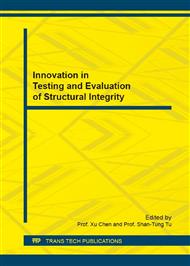[1]
Lei Z, Jun-Yan F. Recent development of high performance pipeline steel. Iron and Steel. 2006; 41: 1-10.
Google Scholar
[2]
Ainsworth RA. R6-Revision 4: 2001, Assessment of the integrity of structure containing defect. London: British Energy Generation Ltd, Amendment. (2001).
Google Scholar
[3]
Standard B. 7910: 2005. Guide to methods for assessing the acceptability of flaws in metallic structures. (2005).
Google Scholar
[4]
Standard A. 579-1/ASME FFS-1 Fitness for Service.: API, (2007).
Google Scholar
[5]
Committee CS, Others. GB/T 19624-2004. Safety Assessment for In-service Pressure Vessels containing Defects (in Chinese). (2004).
Google Scholar
[6]
Linkens D, Formby CL, Ainsworth RA. A Strain-Based Approach to Fracture Assessment - Example Applications. 20008.
Google Scholar
[7]
Budden PJ. Failure assessment diagram methods for strain-based fracture. ENG FRACT MECH. 2006; 73: 537-52.
DOI: 10.1016/j.engfracmech.2005.09.008
Google Scholar
[8]
Budden PJ, Smith MC. Numerical Validation of a Strain-Based Failure Assessment Diagram Approach to Fracture. ASME 2009 Pressure Vessels and Piping Conference2009. pp.1797-806.
Google Scholar
[9]
Budden PJ, Ainsworth RA. The shape of a strain-based failure assessment diagram. INT J PRES VES PIP. 2012; 89: 59-66.
Google Scholar
[10]
Horn A, Trull M, Hertelé S. Failure Prediction of Curved Wide Plates Using the Strain-Based Failure Assessment Diagram With Correction for Constraint and Notch Radius. Journal of Pressure Vessel Technology. 2015; 137: 21208.
DOI: 10.1115/1.4028560
Google Scholar
[11]
Kumar V, Ai E. An Engineering Approach for Elastic-Plastic Fracture Analysis. (1981).
Google Scholar
[12]
Schwalbe K. The crack tip opening displacement and J integral under strain control and fully plastic conditions estimated by the engineering treatment model for plane stress tension: GKSS, (1995).
Google Scholar
[13]
Ernst HA. Effect of the Yield to Tensile Ratio on Structural Integrity of Line Pipes Subjected to Bending Loads. Journal of Offshore Mechanics & Arctic Engineering. 2011; 133: 783-9.
DOI: 10.1115/1.2948944
Google Scholar
[14]
Abaqus. Abaqus/Standard User's Manual, Version 6. 11.: Providence, Rhode Island USA, (2011).
Google Scholar


